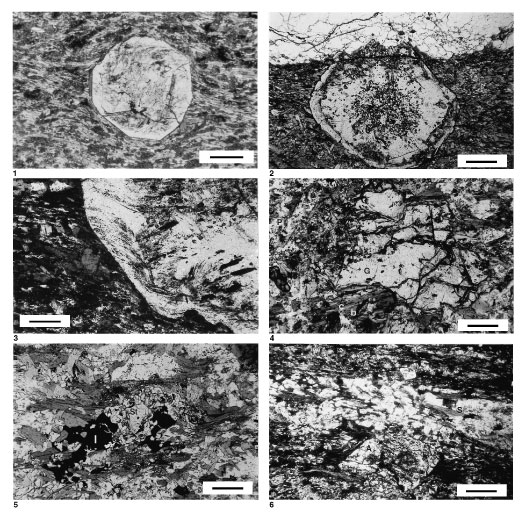
Plate 2. Selected key textural relationships in the high-grade schist. 1. Garnet I porphyroblast surrounded by an idiomorphic rim of garnet II. Garnet I has graphitic and ilmenite inclusion trails defining a rotated internal foliation (S1) oblique to the external foliation S2. Garnet II rim is characterized by the lack of inclusions. Sample 161-976E-22R-1, 15-19 cm. Plane-polarized light. Scale bar is 500 Ám. 2. Example of irregular and sharp boundary between the garnet I (core) and garnet II (rim) zones, suggesting that resorption of garnet occurred between both growth stages. Sample 161-976E-15R-1, 2-7 cm. Plane-polarized light. Scale bar is 500 Ám. 3. Detail of garnet II rim with graphitic inclusions continuous with the external foliation S2. Note the change of orientation of inclusion trails from rim (garnet II zone) to the outermost core (garnet I zone). Sample 161-976B-76R-1, 45-49 cm. Plane-polarized light. Scale bar is 200 Ám. 4. Garnet I porphyroblast (G) partially corroded by a fine-grained aggregate of chlorite (c), plagioclase (P), and quartz. Note how chlorite is also growing at expense of biotite (b). Sample 161-976E-14R-1, 98-102 cm. Plane-polarized light. Scale bar is 200 Ám. 5. Relic staurolite grain (St) partially included in andalusite (A), which also includes large ilmenite aggregates (I). Sample 161-976B-74X-1, 30-34 cm. Plane-polarized light. Scale bar is 200 Ám. 6. Andalusite porphyroblast (A) showing a postkinematic relationship to S2, which is defined by oriented biotite and sillimanite (S) grains. Sample 161-976B-76R-2, 75-78 cm. Plane-polarized light. Scale bar is 500 Ám. Click on image for
enlargement.



![]()